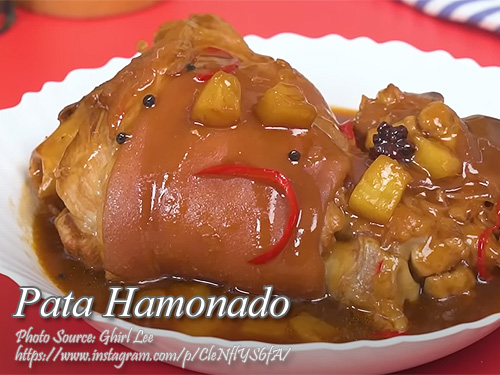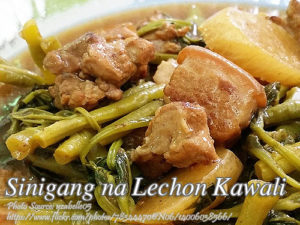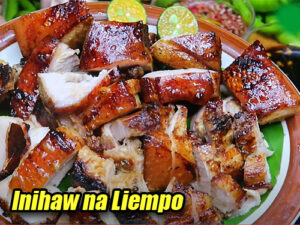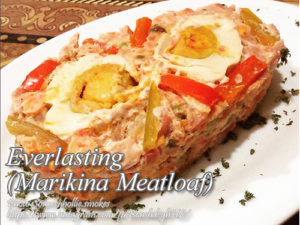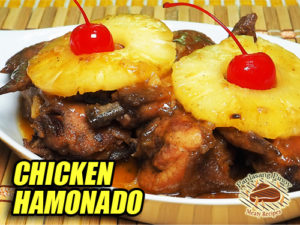This pork pata hamonado recipe is a whole pork pata version of the usual pork hamonado where the meat used is pork belly slab or pork shoulder. This dish is perfect for holiday season specially on Christmas or new years eve. You can also serve this on other occasions or if you are just craving this dish, or can cook this any day you want.
Because it is very simple to cook and doesn’t need long preparations or cooking time. It is even simpler than cooking pata tim or other pata dishes. As simple as putting together all the ingredients in the pot and let it cook until tender. The extra step of searing or braising the pata skin in cooking oil is just an option but is also necessary to bring out the flavor of the pork.
Pork Pata Hamonado: An Old Filipino Nostalgic Classic
Whenever I think of family gatherings, particularly during Christmas or New Year celebrations, there’s always one dish that makes me think the table is whole, and that is pork pata hamonado. My mom, Aling Clara, has sworn in on her version of this dish passed down from her mother and made it for as long as I can remember. It’s not a recipe for us; it’s a family tradition carrying warmth in our celebrations and comfort in familiar flavors.
This entire pork leg recipe is the brother of the more known hamonado, which often employs pork belly or shoulder. The meaty richness of the pata (pork leg) along with the sweet and tangy sauce makes this dish one that everyone loves, from kids to older folks. And honestly, though it looks like something you’d save for a holiday feast, it’s actually pretty simple to make any day of the week.
A Family Favorite for All Occasions
I remember my uncle, Tito Jun, always insisting on having pata at our family reunions. “Mas masarap kung buong pata ang gagamitin,” he’d say, his voice filled with the authority of someone who had tasted years of different family recipes. He believed that the whole pork leg would give a richer flavor than cutting it into smaller pieces. And he’s right-the slow simmering of the meat in pineapple juice, soy sauce, and spices will make for a mouthwatering dish that is both sweet and savory.
This is actually a great dish for special occasions, but you don’t really need a reason to cook it. There are times when the craving hits or I just want a taste of home, that I will whip up a pot of this pork pata hamonado. Every time, the aroma of garlic, onions, and pineapple filling the house brings me right back to those family celebrations.
Secret to Perfect Pork Pata Hamonado: Sear the Pata
It’s one thing that I learned from my older sister, and this is that the pork leg should be browned first before it’s left to simmer in sauce. She was taught this procedure while she was still in Ilocos, known for flavor pork pata. Browning seems somehow an extra step, but believe me-it is what prepares the dish. As you brown that skin it really locks up all the flavors and that’s what, for me, makes the dish pop – well, that and the crispy bits that always form when you fry the meat on the outside.
Once the pata is golden brown to your liking, the rest of the recipe is a piece of cake. Just combine everything—at least pineapple juice, soy sauce, brown sugar, and spices—then let it stew until the pork tenderizes. The hardest part is waiting for the pork to be soft, but the aroma from the kitchen will remind you of its worth.
A Touch of History: The Sweet Legacy of Pork Pata Hamonado
That’s where the sweetness comes in, courtesy of the Spanish influence on Filipino cuisine. Hamonado is a very savory dish; it uses pineapple and sugar to level up its flavors. Native Filipino ingredients fuse with the colonial flavors of the Spaniards. Pineapples abound in the Philippines, and they go well with pork in that sweet and savory dish.
The ones I grew up with will always say that when they were my age, they used to pick fresh pineapples right from their backyard to make this dish. Nowadays, canned pineapple is quite acceptable, and it’s nostalgic because during the 80s and 90s, canned goods were already a staple in every Filipino household.
Cook It Simple, Eat It Joyful
One thing I like about this pork pata hamonado recipe is that you can really make it with minimal effort even for those first-time cooks. My cousin, Paolo, was just starting to cook and prepared this during a family gathering. It turned out to be beautiful! What I learned from my mother was that patience is the secret. Let pork simmer for hours until it absorbs the flavors of everything, and then you’ll be having a dish that simply melts in your mouth.
While most of you may abstain from cooking whole pork leg because it’s a hassle that’s not worth the trouble, really no frills are attached to this recipe. The only “extra” step, really, is searing the pork pata before simmering it with the sauce. And if you’re like me, you’ll appreciate how this minimal effort translates to maximum flavor.
Once the pork is tender and sauce has set just the right, it’s just time to serve. I love finishing my pork with pineapples chunky pieces and bell pieces for an eye-catching look. The fancy presentation is part of the experience, just like when we used to dress up our dishes for big family celebrations.
A Dish That Brings People Together
Over the years, I learned to appreciate more than just the flavors of pork pata hamonado. It’s the way it brings people together-the whole clan on Christmas Eve, the simple Sunday lunch with family and friends-all that I remember-very dearly, over the dinner table.
If you never prepared this recipe, do not worry. Just follow the super duper simple steps in preparing the dish below and soon you will have a pot of savory hamonado so loved by your family. And as soon as the day comes, like for me, to cook it for your kids, it will be for passing on, not only the recipe, but a piece of your family’s history.
How to Cook Pork Pata Hamonado
Ingredients
- 1 whole Pork hock or pork pata
- salt to taste (for rubbing the pork pata)
- 4 cloves minced garlic
- 1/4 cup minced onion
- 3-4 pcs star anise
- 3 pcs bay leaves or laurel leaves
- 1 tsp whole black pepper or black peppercorns
- 1 pc cinnamon stick (optional)
- 2 Tbsp. cooking oil for sautéing
- 2 cups pineapple juice
- 4 cups water (or just enough to cover the pata)
- 3 tbsp vinegar
- 1/4 cup soy sauce
- 1/4 cup tomato sauce
- 1/2 cup brown sugar
- salt to taste
- 1 cup pineapple chunks
- 1/2 pc sliced red bell peppers
- 1 Tbsp. cornstarch + 2 Tbsp. water slurry to thicken
Instructions
How to Cook Pata Hamonado
- Remove hairs and nails of the whole pork pata. Wash and drain and let it dry. Rub with salt and let it stand for a few hours.
- In a large pot, heat cooking oil and sauté onion, garlic, laurel leaves, star anise, black peppercorns and cinnamon sticks (optional).
- Add the pork pata in the pot and sear the skin until slightly brown. Add pineapple juice, water, vinegar, soy sauce, tomato sauce and brown sugar.
- Bring to a boil and simmer for an hour or until almost tender. Then add pineapples, bell pepper and cornstarch slurry.
- Then simmer again until the pork is tender while basting the pata skin with the sauce.
- When cooked, transfer to a serving dish and garnish with the pineapples and bell peppers on top while pouring the sauce on the pata. Serve hot.
Notes
Cooking Tips or Pork Pata Hamonado:
Fry the Pork for Deeper Flavours
What makes it special is that searing the pata before simmering helps lock in the flavor and beautifully brings a golden crust to the pork. The procedure enhances the general taste brought about by creating a deeper, richer flavor of the dish. So do not skip this part, because that is also what gives your Hamonado that additional layer of deliciousness.Simmer Low and Slow for Tender Meat
And, the technique for fall-off-the-bone tenderness is to cook it at low heat for a very long time. That way, the meat would have taken on all the sweet and savory flavors of the sauce, yet remain juicy. Patience is the word-you'll ruin it by cooking it too fast to have tough, undercooked pork.Thicken the Sauce Just right
To make a sauce even thicker and more luscious, it can be made from a slurry made of cornstarch in water. Add this towards the end of cooking and continuously stir out lumps. This helps your sauce adhere well to the pork with good texture.
